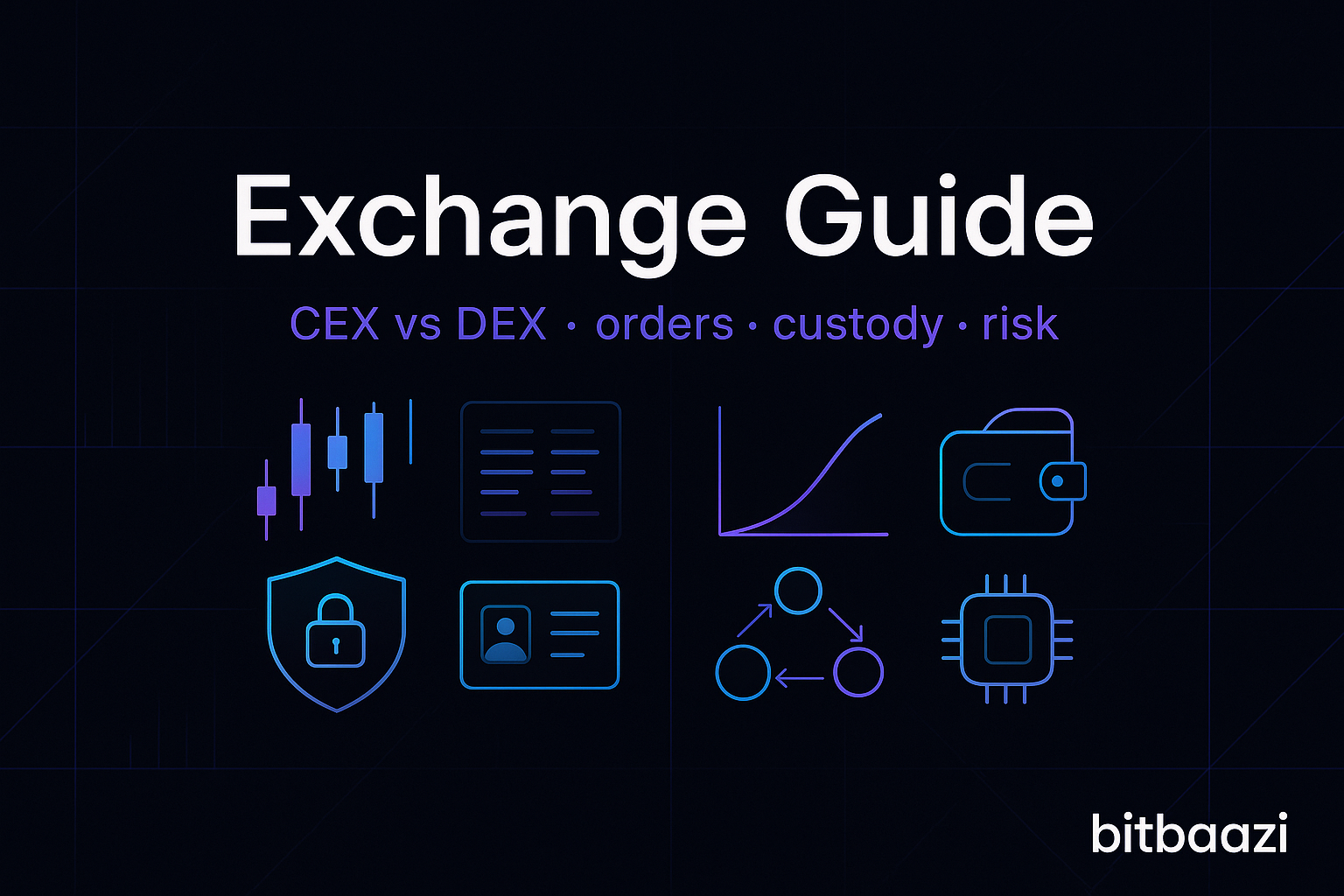Summary
- CEX vs DEX, custody, and transparency—what to vet before trading.
- Learn order books, AMMs, liquidity, and price formation.
- Check risk controls: proof-of-reserves, insurance pools, disclosures.
- Prefer venues with clear rules, audits, and strong wallet security.
Intro. Good venues match buyers and sellers under clear rules. In this primer we use “Exchange” to mean both custodial platforms (CEX) and non-custodial protocols (DEX). You’ll learn how they work, what risks to check, and how to choose safely without investment advice.
What these platforms do
They route orders and settle assets under specific market and custody models.
CEXs use order books, keep client assets in custody, and must meet KYC/AML obligations defined by bodies like the FATF’s 2019/2021 standards and later updates; DEXs execute swaps via AMMs and non-custodial wallets. FATF’s Oct 28, 2021 update clarifies licensing/Travel Rule scope, and a June 2024 targeted update shows uneven global implementation, so venue compliance can vary by country.
CEX vs DEX in practice
Custody, order routing, and settlement differ, so user responsibilities differ too.
On DEX, AMMs like Uniswap v3 (mainnet May 5, 2021) introduced concentrated liquidity and multiple fee tiers, improving capital efficiency and execution paths without custodial risk. On CEX, you get unified UX, fiat ramps, and margin/futures, but you must assess custody practices, audits, and controls.
How to choose a platform safely
Focus on solvency, security, transparency, jurisdiction, and your own ops hygiene.
Solvency signals. Independent Proof-of-Reserves (PoR) with user-verifiable inclusion is a strong signal; Kraken’s July 30, 2025 attestation (snapshot as of 2025-06-30) reiterates 1:1 coverage and user-level verification via Merkle proofs. Prefer venues that publish regular scopes and methodologies.
Protection buffers. Some venues keep insurance pools—e.g., Binance’s Secure Asset Fund for Users (established July 2018; valued at ~$1B on 2022-01-31, with public wallet addresses)—as incident backstops, though not a guarantee. Treat such funds as one layer, not a substitute for your own controls.
Custody design. Review how keys are split, where funds are segregated, audit regimes (e.g., SOC reports), and incident playbooks; Coinbase outlined custody principles and scale (post dated Mar 4, 2024), including segregation and insurance details.
Compliance posture. Check KYC/Travel Rule readiness and licensing/registration status per FATF 2021 guidance and 2024 targeted update; fragmented global uptake means features and limits can differ by country.
FAQ
- What is Proof-of-Reserves?
A third-party attestation that client liabilities are fully covered; e.g., Kraken 2025-06-30. - When did Uniswap v3 go live?
Uniswap v3 deployed to Ethereum mainnet on 2021-05-05 with concentrated liquidity. - What is the Travel Rule?
An FATF requirement to share originator/beneficiary info between VASPs; updated 2021/2024. - What is Binance SAFU?
An insurance pool started in 2018; valued around $1B on 2022-01-31 with public wallet addresses.
■ Takeaways
- Prefer venues with regular PoR, clear scopes, and user-verifiable inclusion.
- Treat insurance funds as supplemental; maintain your own security controls.
- Verify KYC/Travel Rule and licensing status in your jurisdiction.
- Use hardware-key 2FA, withdrawal allow-listing, and small test sends first.
- Remember: this guide is informational only, not investment advice.
作用与范式
它们撮合买卖并在特定的托管与结算模型下完成清算。
本文用 “Exchange” 作为托管型平台(CEX)与去托管协议(DEX)的总称。CEX 以订单簿与托管为核心,需遵守 KYC/AML 与 Travel Rule;FATF 于 2021-10-28 更新了虚拟资产/VASP 的风险为本指引,并在 2024-06 发布针对实施进展的更新,显示各司法辖区执行仍不均衡。DEX 借助 AMM 实现点对点撮合与自托管钱包结算。
CEX 与 DEX 的实际差异
托管、路由与清算路径不同,用户责任与权衡也不同。
以 DEX 而言,Uniswap v3 在 2021-05-05 主网上线,引入集中流动性与多费率,提高资金效率与执行效果;以 CEX 而言,应评估托管分离、审计与风控,以及是否具备法币出入金与合规能力。
如何安全地选择平台
围绕偿付能力、安全机制、透明度、属地合规与自我操作纪律进行检查。
偿付能力。 优先关注可按账户级验证的 PoR;例如 Kraken 于 2025-07-30 公布的审验(快照日 2025-06-30)强调 1:1 覆盖与默克尔证明。
风险缓冲。 一些平台设置保险池,如 Binance 自 2018 年起设立 SAFU,并在 2022-01-31 公告估值约 10 亿美元且公开钱包地址;将其视为补充层,不可替代自有安全。
托管设计。 关注密钥分片、资金隔离、审计与应急预案;例如 Coinbase 于 2024-03-04 介绍其托管原则与保险安排。
合规态势。 参考 FATF 2021 年更新与 2024 年针对性更新,因各地推进不一,功能与限额可能因地而异。
役割と基本構造
買い手と売り手を結び、所定の托管・清算モデルで資産を移転する。
本稿では “Exchange” を CEX(カストディ型)と DEX(非カストディ型)の総称とする。CEX は注文簿とカストディを前提に KYC/AML とトラベルルールへ対応が必要で、FATF は 2021-10-28 に更新指針を公表、2024-06 のターゲテッド・アップデートでも各国の実施状況のばらつきを示した。DEX は AMM により自主管理ウォレットでの即時決済を行う。
CEX/DEX の実務差
カストディ、ルーティング、清算の設計差がユーザー責任と運用を左右する。
DEX の例として Uniswap v3 は 2021-05-05 にメインネット実装し、集中流動性と複数手数料で資本効率と執行品質を高めた。CEX では UX と法定通貨の出入金、デリバティブ等の利便性がある一方、資産分別・監査・統制の精査が不可欠である。
安全に選ぶための視点
支払能力、安全設計、開示、法域、運用衛生を軸に総合判断する。
支払能力。 ユーザ検証可能な PoR を重視。Kraken は 2025-07-30 に最新結果を公開(スナップショット 2025-06-30)。
緩衝層。 一部は保険基金を備える。Binance は 2018 年に SAFU を開始し、2022-01-31 に約 10 億ドル規模と公開アドレスを示した。
カストディ設計。 鍵分散、分別管理、監査、保険、インシデント対応。Coinbase は 2024-03-04 に原則を解説。
コンプライアンス。 FATF 2021/2024 を参照。各国の実装差により利用条件が変わりうる。
